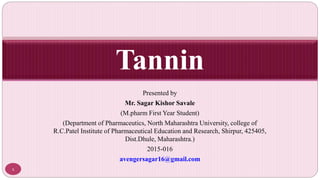The document presents an extensive overview of tannins, secondary metabolites found in plants, detailing their structures, classifications, functions, properties, and medicinal uses. Tannins are known for their astringent and antioxidant properties, playing significant roles in plant protection and consumer acceptance of specific foods and beverages. Furthermore, it discusses various applications of tannins in industries such as leather tanning and potential medical benefits, especially in treating conditions like diarrhea and as antidotes in poisoning.



![4
2. Structure and classes of tannins
There are three major classes of tannins] Shown below are the base unit or monomer of the tannin. Particularly in the flavone-derived
tannins, the base shown must be (additionally) heavily hydroxylated and polymerized in order to give the high molecular weight
polyphenol motif that characterizes tannins. Typically, tannin molecules require at least 12 hydroxyl groups and at least five phenyl
groups to function as protein binders.](https://image.slidesharecdn.com/sagar1-151201064152-lva1-app6892/85/Tannin-4-320.jpg)












![17
9.1.1 Myrobalan
9.1 Hydrolysable tannin
Synonyms-harde , haritaki.
Biologicale source- it consist dried frute of plant terminalia chebula belonging to family combretaceae
Geographcale source-india , asam , mharashtra
Morphologicale character-
Colour-yellowish colur
Odour-odourless
Taste-astringent
Size-20 to 25 mm long
Shape-ovate
Chemical constituents-it can consist gallic acid and ellagic acid ,main chemical constituent is chebulegic acid and chebulinic acid.
Chemical test-in presence of tannin protein get ppt , in presence of metal tannin get ppt.[lead acetate – white ppt]
Use-astrigent , laxative, antihelmintic, ayurvedic prepration triphla](https://image.slidesharecdn.com/sagar1-151201064152-lva1-app6892/85/Tannin-17-320.jpg)
![18
9.1.2 Bahera
Synonyms -Baheda
Biologicale source- it consist dried frute of plant terminalia belirica belonging to family combretaceae
Geographicale source-India, sri-lanka, Malaya
Morphology-
Colour-brownish colur
Odour-odourless
Taste-astringent
Size-1.5 to 2 mm long
Shape-ovate
Chemical constituents-it can consist pyrogallole gallic acid and ellagic acid.
Chemical test-in presence of tannin protein get ppt , in presence of metal tannin get ppt.[lead acetate – white ppt]
Use-astingent , laxative , dyspepsia , diarrhea , purgative.](https://image.slidesharecdn.com/sagar1-151201064152-lva1-app6892/85/Tannin-18-320.jpg)

![20
9.1.4 Arjuna
Synonyms-Arjun bark
Biological source-It can consist of dried stem bark of plant terminalia arjuna belonging to family combrataceae
Geogrraphicale source -India , chotta-nagpur region.
Morphology-
Colour – greyish brown
Odour – characteristics
Taste – astringent
Size-1.5 to 2.5 mm diameter
Shape-flats
Chemical constituents- Main chemical constituents is Arjunine, arjunc acid,arjunetine, other is gallic acid , ellagic acid.
Chemical test-in presence of tannin protein get ppt , in presence of metal tannin get ppt.[lead acetate – white ppt]
Use-It is used in cardiotonic , vasodialatores and dceases heart rate. astingent , laxative , dyspepsia , diarrhea , purgative.](https://image.slidesharecdn.com/sagar1-151201064152-lva1-app6892/85/Tannin-20-320.jpg)

![22
9.2.2 Black catechu
Synonyms - catechu, Kattha, cutch,
Biologicale source – it consis of dried aq.extract of heart wood plant acacia catechu belonging to family leguminosae.
Geographical source – India, Pakistan, U.S.A. Sri Lanka
Chemical constituents – it can contain 10% of acacatechin it is diastreomer of 5, 7, 3’, 4’ tetrahydroxy flavan 3-ol, catechu tannic acid, tannic acid
Morphology- Colour – light brown black
Odour – none
Taste – astringrnt
Solibility in water – completely. ; Solibility in alcohol –soluble.
Chemical test -
1]Catechu + alcoholic vanilline +hydrochloric acid - Pink colour
2]Aq.extract of drug + lime water - Brown colour tun to red
3]Dil.solution catechu + ferric ammonium sulphate solution - Green colour
4]Dip matchstick in Hcl & heate near theflame - Purple colour
5]Potassium permagnet - Decolourisation
Use – astringent, for boiling, ulcers, it is used in cough and diarrhea, cooling & digestive properties.](https://image.slidesharecdn.com/sagar1-151201064152-lva1-app6892/85/Tannin-22-320.jpg)
![23
9.2.3 Pale catechu
Synonyms – gambier ,gambir,catechu
Biologicale source – it is drird aq.extract of the leaves & young shoots of uncaria gambier belonging to family of rubiaceae.
Geographicale source - plant native to south east Asian region like arachipelago in Malaysia , sigapore and Indonesia.
Chemical constituents – drug containing catechu, catechu tannic acid , catechu red
Morphology-
Colour – raddiish brown
Odour – none
Taste – astringrnt
Chemical test-
1]Lead acetate White Buff ppt (tests 1 to 5 same as above black catechu)
2]Gambiur florecin test [alcohol+sodium hydroxide solution+few drops of light petroleum+shake] Green fluorescense
observed in petroleum layer
3]Chloroform extract evaporate to dryness Greenish yellow colour
Use – it is used as astringent of diarrhoea and local astringent in the form of lozenges.](https://image.slidesharecdn.com/sagar1-151201064152-lva1-app6892/85/Tannin-23-320.jpg)


